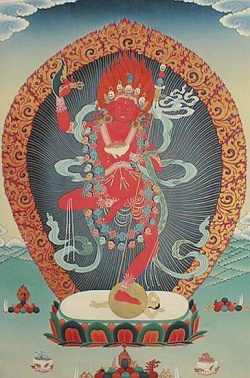Vajrayogini - Vajravarahi
Vajravarahi (Tibetan: Dorje Pagmo, Sanskrit: Vajravarahi, English: the Vajra Sow) accompanied by 12 dakinis.
Red in colour, slightly peaceful and slightly wrathful, with one face and two hands she gazes forward with three eyes. The face of a brown female boar protrudes from her right side behind the ear. Held aloft in the right hand is a curved knife and to the heart with the left a skullcup. The bend of the elbow cradles a vajra katvanga staff - gold coloured, long and thin. Crowned with a tiara of five skulls the black hair of the head flows downward behind. Adorned with gold earrings, necklaces, bracelets and a girdle with decorative tassels, she wears a garland of fifty fresh heads. Draped across the shoulders is a long scarf of yellow and green. The right leg is raised in a dancing posture and the left presses upon a small red sun disc atop a prone yellow figure above another sun disc resting on a multi-coloured lotus blossom surrounded by a large red sphere of tightly swirling flames of pristine awareness fire.
There are 12 attendant dakinis around her. Each has one face and two hands holding a curved knife and skullcup with a vajra katvanga staff in the elbow. Wearing the same ornaments and standing in a dancing posture, each is surrounded by a circle of fire.
Vajravarahi, along with numerous variations in appearance such as Vajrayogini and the Fierce Black One, remains one of the most popular and special tutelary deity practices arising from the Chakrasamvara cycle of tantras belonging to the wisdom class of Anuttarayoga Tantra. These various forms are practiced in all the Sarma Schools, Sakya, Kagyu and the like.
